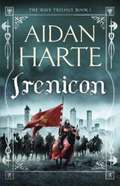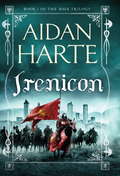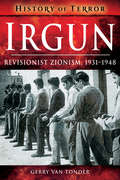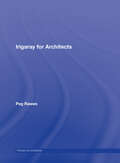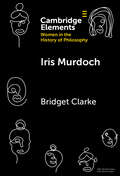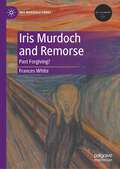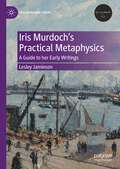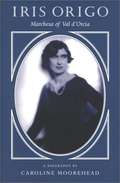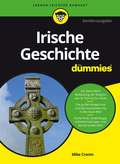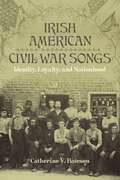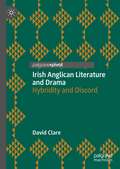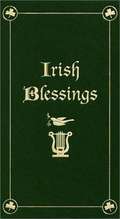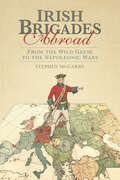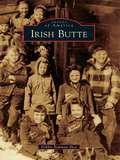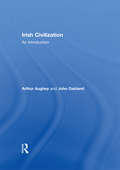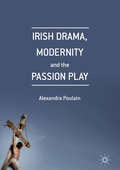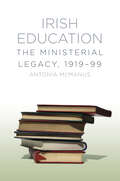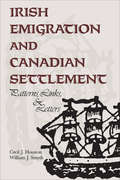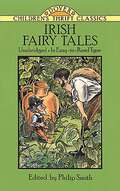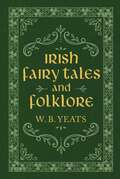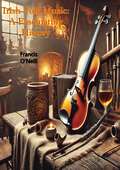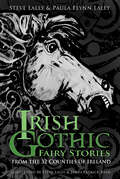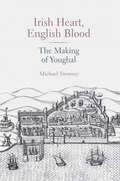- Table View
- List View
Irenicon
by Aidan Harte"If there were stars for world-building, Irenicon would be a five plus, no question," says SFX. "The book is a fountain of gorgeous detail, festooned with enriching codices and enlightening, subtly subsumed exposition," raved Sci-Fi Now. The river Irenicon is a feat of ancient Concordian engineering. Blasted through the middle of Rasenna in 1347, using Wave technology, it divided the only city strong enough to defeat the Concordian Empire. But no one could have predicted the river would become sentient--and hostile. Sofia Scaligeri, the soon-to-be Contessa of Rasenna, has inherited a city tearing itself apart from the inside. And try as she might, she can see no way of stopping the culture of vendetta that has the city in its grasp. Until a Concordian engineer arrives to build a bridge over the Irenicon, clarifying everything: the feuding factions of Rasenna can either continue to fight each other or they can unite against their shared enemy. And they will surely need to stand together--for Concord is about to unleash the Wave again.
Irenicon: The Wave Trilogy Book 1
by Aidan Harte'Irenicon is completely fascinating' - Thinking About BooksThe river Irenicon is a feat of Concordian engineering. Blasted through the middle of Rasenna in 1347 using Wave technology, it divided the only city strong enough to defeat the Concordian Empire. But no one could have predicted it would become sentient, and hostile. Sofia Scaligeri, the soon-to-be Contessa of Rasenna, is inheriting a city tearing itself apart from the inside. She can see no way of stopping Rasenna's culture of vendetta . . . until a Concordian engineer arrives to build a bridge over the Irenicon. He shows her that the feuding factions of Rasenna can continue to fight each other, or they can unite against Concord. And they will need to stand together - for Concord is about to unleash the Wave again . . .Set in a darkly original alternative Renaissance Italy, Irenicon is a gripping adventure, a tragic love story and a very modern tale of redemption.
Irenicon: The Wave Trilogy Book 1 (Irenicon)
by Aidan Harte'Irenicon is completely fascinating' - Thinking About BooksThe river Irenicon is a feat of Concordian engineering. Blasted through the middle of Rasenna in 1347 using Wave technology, it divided the only city strong enough to defeat the Concordian Empire. But no one could have predicted it would become sentient, and hostile. Sofia Scaligeri, the soon-to-be Contessa of Rasenna, is inheriting a city tearing itself apart from the inside. She can see no way of stopping Rasenna's culture of vendetta . . . until a Concordian engineer arrives to build a bridge over the Irenicon. He shows her that the feuding factions of Rasenna can continue to fight each other, or they can unite against Concord. And they will need to stand together - for Concord is about to unleash the Wave again . . .Set in a darkly original alternative Renaissance Italy, Irenicon is a gripping adventure, a tragic love story and a very modern tale of redemption.
Irgun: Revisionist Zionism, 1931–1948 (History of Terror)
by Gerry van TonderA history of the controversial underground group that employed political violence in its quest to create an independent Israel. Includes photos. In October 1944, the US Office of Strategic Services described the Irgun Tsvai Leumi—National Military Organization—as &“an underground, quasi-military organization with headquarters in Palestine . . . fanatical Zionists who wish to convert Palestine and Transjordan into an independent Jewish state [and] advocate the use of force both against the Arabs and the British to achieve this maximal political goal.&” This book delves into the origins and history of Irgun. In 1925, Ze&’ev Jabotinsky founded the Revisionist Zionism organization, whose secular, right-wing ideology would lead to the formation of the Irgun and, ultimately, of the Likud Party. Commencing operations in the British Mandate of Palestine in 1931, Irgun adopted a mainly guarding role, while facilitating the ongoing immigration of Jews into Palestine. In 1936, Irgun guerrillas started attacking Arab targets. The British White Paper of 1939 rejected the establishment of a Jewish nation, and as a direct consequence, Irgun guerrillas started targeting the British. The authorities executed captured Irgun operatives found guilty of terrorism, while deporting hundreds to internment camps overseas. As details of Jewish genocide—the Holocaust—emerged, Irgun declared war on the British in Palestine. Acts of infrastructural sabotage gave way to the bombing of buildings and police stations, the worst being the bombing of the King David Hotel in Jerusalem—the hub of British operations and administration—in July 1946, killing ninety-one. Freedom fighters or terrorists, Irgun was only dissolved when the independent Jewish state of Israel was born on May 14, 1948. This is their story.
Irigaray for Architects (Thinkers for Architects)
by Peg RawesSpecifically for architects, the third title in the Thinkers for Architects series examines the relevance of Luce Irigaray’s work for architecture. Eight thematic chapters explore the bodily, spatio-temporal, political and cultural value of her ideas for making, discussing and experiencing architecture. In particular, each chapter makes accessible Irigaray’s ideas about feminine and masculine spaces with reference to her key texts. Irigaray’s theory of ‘sexed subjects’ is explained in order to show how sexuality informs the different ways in which men and women construct and inhabit architecture. In addition, her ideas about architectural forms of organization between people, exterior and interior spaces, touch and vision, philosophy and psychoanalysis are explored. The book also suggests ways in which these strategies can enable architectural designers and theorists to create ethical architectures for the user and his or her physical and psychological needs. Concisely written, this book introduces Irigaray’s work to practitioners, academics, undergraduate and postgraduate students in architectural design and architectural history and theory, helping them to understand the value of cross- and inter-disciplinary modes of architectural practice.
Iris Murdoch (Elements on Women in the History of Philosophy)
by Bridget ClarkeIris Murdoch is well-known for her moral philosophy, especially for the light it sheds on the inner life. This Element focuses on the political significance and contours of Murdoch's ethics. Its chief aim is to illuminate the affinities between Murdoch's concept of the individual and the Enlightenment ideal of a society in which people live together as free equals. There are five sections in this Element. Section 1 provides context for the discussion. Section 2 compares what Murdoch calls the liberal and naturalistic outlooks and argues that she develops a modified version of the naturalistic outlook to better support an Enlightenment sensibility. Sections 3 and 4 examine the three main features of Murdoch's 'naturalized' individual. Section 3 considers the individual's uniqueness and transcendence. Section 4 considers the individual's knowability through love. Section 5 offers some concluding remarks.
Iris Murdoch and Remorse: Past Forgiving? (Iris Murdoch Today)
by Frances WhiteThis exploration of the crucially important role played by remorse in Iris Murdoch’s philosophical, theological, and political thinking identifies it as a critical concept in her moral psychology and a recurrent theme in her art. Through engagement with Simone Weil, current theories of remorse, trauma theory and Holocaust studies, it offers fresh perspectives on Murdoch’s fiction – particularly the late novels, her radio play The One Alone, and her monograph Heidegger.
Iris Murdoch’s Practical Metaphysics: A Guide to her Early Writings (Iris Murdoch Today)
by Lesley JamiesonThis book explores Iris Murdoch as a philosopher who, through her distinctive methodology, exploits the advantages of having a mind on the borders of literature and politics in her early career writings (pre-The Sovereignty of Good). By focusing on a single decade of Murdoch’s early career, Jamieson tracks connections between her views on the state of literature and politics in postwar Britain and her approach to the philosophy of mind and moral philosophy. Furthermore, this close study reveals that, far from a stylistic quirk, Murdoch’s use of metaphors, analogies, and other literary devices is internal to her methodology. Finally, rather than asking what Murdoch’s views are, this work will ask “what is Murdoch trying to achieve with her writings and public lectures, and how does she go about this?” By answering the latter question, we will have a new strategy for interpreting her writings more generally. The book contributes to the growing body of scholarship focusing on Iris Murdoch’s philosophical writings, and on women in the history of analytic philosophy.
Iris Origo: Marchesa of Val d'Orcia
by Caroline MooreheadIris Origo was one of those rare characters who, despite being born with a platinum spoon in her mouth, went on to accomplish great things. In Origo's case, she managed to add light & color to everything she touched & left for posterity a legacy of work, biography, autobiography, & literary criticism that have become recognized as classics of their kind.
Irische Geschichte für Dummies (Für Dummies)
by Mike CroninDie Iren erzählen gerne Geschichten; ihre Geschichte ist es auch wert, erzählt zu werden. Mythische Könige, Invasoren und Missionare: Auf der Insel ging es schon früh hoch her. Später kamen die Engländer, der lange Kampf der Iren gegen die Invasoren, Hunger, Auswanderung, Freiheit und Teilung. Mike Cronin hilft Ihnen, den Irlandkonflikt zu verstehen und berichtet vom Werden und Wirken großer Iren.
Irish American Civil War Songs: Identity, Loyalty, and Nationhood (Conflicting Worlds: New Dimensions of the American Civil War)
by Catherine V. BatesonIrish-born and Irish-descended soldiers and sailors were involved in every major engagement of the American Civil War. Throughout the conflict, they shared their wartime experiences through songs and song lyrics, leaving behind a vast trove of ballads in songbooks, letters, newspaper publications, wartime diaries, and other accounts. Taken together, these songs and lyrics offer an underappreciated source of contemporary feelings and opinions about the war.Catherine V. Bateson’s Irish American Civil War Songs provides the first in-depth exploration of Irish Americans’ use of balladry to portray and comment on virtually every aspect of the war as witnessed by the Irish on the front line and home front. Bateson considers the lyrics, themes, and sentiments of wartime songs produced in America but often originating with those born across the Atlantic in Ireland and Britain. Her analysis gives new insight into views held by the Irish migrant diaspora about the conflict and the ways those of Irish descent identified with and fought to defend their adopted homeland. Bateson’s investigation of Irish American song lyrics within the context of broader wartime experiences enhances our understanding of the Irish contribution to the American Civil War. At the same time, it demonstrates how Irish songs shaped many American balladry traditions as they laid the foundation of the Civil War’s musical soundscape.
Irish Anglican Literature and Drama: Hybridity and Discord
by David ClareThis book discusses key works by important writers from Church of Ireland backgrounds (from Farquhar and Swift to Beckett and Bardwell), in order to demonstrate that writers from this Irish subculture have a unique socio-political viewpoint which is imperfectly understood. The Anglican Ascendancy was historically referred to as a “middle nation” between Ireland and Britain, and this book is an examination of the various ways in which Irish Anglican writers have signalled their Irish/British hybridity. “British” elements in their work are pointed out, but so are manifestations of their proud Irishness and what Elizabeth Bowen called her community’s “subtle … anti-Englishness.” Crucially, this book discusses several writers often excluded from the “truly” Irish canon, including (among others) Laurence Sterne, Elizabeth Griffith, and C.S. Lewis.
Irish Blessings: With Legends, Poems & Greetings
by Kitty NashHere is a collection of short Irish blessings, prayers, poems and legends. Collectively they honor the Irish people's love of their country, friendship, humor, friendship, god, history and more. They will touch your day with inspiration, feelings of encouragement, cheer, gratitude and wit. They are also material to be shared to uplift your family and friends. Most of the entries are anonymous but Irelands writers and collector's of traditions are also represented.
Irish Brigades Abroad: From the Wild Geese to the Napoleonic Wars
by Stephen McGarryIrish Brigades Abroad examines the complete history of the Irish regiments in France, Spain, Austria and beyond. Covering the period from King James II’s reign of the three kingdoms of England, Scotland and Ireland in 1685, until the disbandment of the Irish Brigades in France and Spain, this book looks at the origins, formation, recruitment and the exploits of the Irish regiments, including their long years of campaigning from the War of the Grand Alliance in 1688 right through to the Napoleonic Wars in 1815. What emerges is a picture of the old-fashioned virtues of honour, chivalry, integrity and loyalty, of adventure and sacrifice in the name of a greater cause.
Irish Butte (Images of America)
by Debbie Bowman SheaSummoned by the call of the copper mines in Butte, Montana, Irish immigrants left a struggling Ireland at the beginning of the 20th century in search of a better life. Around the mines peppering the hills of the mining city, these determined sons and daughters of Eire built strong Irish neighborhoods that engendered the best of Irish culture and influence. Faith, family, a strong work ethic, and a sense of humor would see these immigrants through the decades. Celebrations like St. Patrick's Day and An Ri Ra, Irish language workshops, and a new generation of Irish artisans acknowledge the contributions of this influential group.
Irish Canadian Conflict and the Struggle for Irish Independence, 1912-1925
by Robert MclaughlinBetween 1912 and 1925, Ireland convulsed with political and revolutionary upheaval in pursuit of self-government. Canadians of Irish descent, both Catholic and Protestant, diligently followed these conflicts, and many became actively involved in the dramatic events overseas. Irish Canadian Conflict and the Struggle for Irish Independence tells the unique story of how Irish Canadians identified with their ancestral homeland during this revolutionary era. Drawing on ethnic weekly newspapers and fraternal society records, Robert McLaughlin finds new interpretations of how Orange Canadian unionists and Irish Canadian nationalists viewed their heritage, their membership in the British Empire, and even Canadian citizenship itself.McLaughlin also provides strong evidence that neither time nor distance diminished Irish Canadians' attachment to their familial homeland or their identification with their respective ethnic communities in Ireland. Irish Canadian Conflict and the Struggle for Irish Independence reconsiders existing contextual frameworks and confronts the challenging questions inherent in understanding this period.
Irish Civilization: An Introduction
by Arthur Aughey John OaklandIrish Civilization provides the perfect background and introduction to both the history of Ireland until 1921 and the development of Ireland and Northern Ireland since 1921. This book illustrates how these societies have developed in common but also those elements where there have been, and continue to be, substantial differences. It includes a focus on certain central structural aspects, such as: the physical geography, the people, political and governmental structures, cultural contexts, economic and social institutions, and education and the media. Irish Civilization is a vital introduction to the complex history of Ireland and concludes with a discussion of the present state of the relationship between them. It is an essential resource for students of Irish Studies and general readers alike.
Irish Drama, Modernity and the Passion Play
by Alexandra PoulainThis book discusses Irish Passion plays (plays that rewrite or parody the story of the Passion of Christ) in modern Irish drama from the Irish Literary Revival to the present day. It offers innovative readings of such canonical plays as J. M. Synge’s The Playboy of the Western World, W. B. Yeats’s Calvary, Brendan Behan’s The Hostage, Samuel Beckett’s Endgame, Brian Friel’s Faith Healer and Tom Murphy’s Bailegangaire, as well as of less well-known plays by Padraic Pearse, Lady Gregory, G. B. Shaw, Seán O’Casey, Denis Johnston, Samuel Beckett and David Lloyd. Challenging revisionist readings of the rhetoric of “blood sacrifice” and martyrdom in the Irish Republican tradition, it argues that the Passion play is a powerful political genre which centres on the staged death of the (usually male) protagonist, and makes visible the usually invisible violence perpetrated both by colonial power and by the postcolonial state in the name of modernity.
Irish Education: The Ministerial Legacy
by Antonia McManusIn this important new work, the author analyses the contributions that our Ministers for Education made to the Irish education system between the years 1919 and 1999. Covering the social, economic and political realities of the time, and taking in the involvement of the OECD , what emerges is a picture of how Irish education was shaped and moulded over the course of the twentieth century.
Irish Emigration and Canadian Settlement: Patterns, Links, and Letters
by William J. Smyth Cecil J. HoustonIn mid-nineteenth-century Canada, the Irish outnumbered the English and Scots two to one. Yet they have been much less studied than their US counterparts, even though their experience was very different. Irish settlers arrived earlier in Canada, formed a larger proportion of the founding communities, and were largely rural-based; more than half were Protestant. The Famine provided only a rather late part of the Irish emigration to Canada, which took place principally between 1816 and 1855. The authors evaluate both emigration and settlement and present as well revealing personal documents about intense, often painful experiences of the settlers. Part I explores the geographical links – particularly the phenomenon of chain migration – that shaped decisions to leave Ireland. Part II examines patterns of settlement in the new land. Part III, with biographies of immigrants and collections of letters written home, chronicles personal and social life in the new land and the abiding interest in family and friends in Canada and back in Ireland. The documents illustrate links and patterns revealed in the earlier analysis of emigration and settlement; they also offer an additional, intimate perspective on a key phase in the cultural history of Canada and Ireland.
Irish Fairy Tales (Dover Children's Thrift Classics)
by Philip SmithEight charming tales full of the whimsy and wordplay of Irish folklore. Newly reset in large, easy-to-read type are: "Hudden and Dudden and Donald O'Neary," "Conal and Donal and Taig," "The Old Hag's Long Leather Bag," "The Field of Boliauns," "The Sprightly Tailor," and more. 6 new illustrations enhance the text.
Irish Fairy Tales and Folklore
by W. B. YeatsA classic collection of Irish fairy tales and lore by Nobel Peace Prize-winning author and poet W. B. YeatsOriginally published as two separate volumes in 1800s, this premier collection of Irish stories edited and compiled W. B. Yeats is the perfect gift for any lover of Irish literature and folklore. The lyrical prose and rich cultural heritage of each tale will captivate and enchant readers of all ages and keep them entertained for hours on end.This volume contains more than seventy classic Irish stories, including timeless characters and mythology passed down for generations such as:The Trooping FairiesChangelingsTir-na-n-ógThe LepracaunThe Kildare PookaHow Thomas Connolly met the BansheeAnd many more!
Irish Folk Music: A Fascinating History
by Francis O'NeillFrancis O'Neill’s "Irish Folk Music: A Fascinating History" is an enchanting exploration of the rich and vibrant tradition of Irish folk music. With the keen insight of a scholar and the passion of a dedicated musician, O'Neill delves into the origins, evolution, and cultural significance of this beloved musical heritage.O'Neill, an esteemed musicologist and collector, provides readers with a comprehensive account of the development of Irish folk music from its ancient roots to its modern expressions. He traces the influences that have shaped this genre, from the ancient Celtic melodies to the contributions of successive generations of musicians and composers. The book examines the diverse forms of Irish folk music, including jigs, reels, airs, and ballads, and highlights the instruments that give this music its distinctive sound, such as the fiddle, tin whistle, and uilleann pipes."Irish Folk Music: A Fascinating History" is more than just a historical overview; it is a celebration of the people and communities who have kept this tradition alive. O'Neill shares captivating stories of legendary musicians and iconic performances, bringing to life the vibrant personalities and events that have defined Irish folk music. He also explores the role of music in Irish society, from its function in traditional celebrations and communal gatherings to its influence on national identity and cultural expression.The book is richly illustrated with musical notations, historical photographs, and anecdotes that enhance the reader's understanding and appreciation of the music. O'Neill’s engaging writing style makes complex musical concepts accessible, allowing both musicians and general readers to enjoy the journey through Ireland's musical landscape."Irish Folk Music: A Fascinating History" is an essential read for anyone interested in the cultural heritage of Ireland. Francis O'Neill’s authoritative and heartfelt account provides a deep appreciation of the artistry and tradition that have made Irish folk music a beloved and enduring part of global musical culture. This book stands as a tribute to the timeless beauty and profound influence of Ireland's musical legacy.
Irish Gothic Fairy Stories: From the 32 Counties of Ireland
by Steve Lally Paula Flynn Lally James Patrick RyanIn the four provinces of Ireland there are thirty-two counties. Each county and its people have their own traditions, beliefs and folklore – and each one is also inhabited by the Sidhe: an ancient and magical race. Some believe they are descended from fallen angels, whilst others say they are the progeny of Celtic deities. They go by many names: the good folk, the wee folk, the gentle people and the fey, but are most commonly known as ‘the fairies’.These are not the whimsical fairies of Victorian and Edwardian picture books. They are feared and revered in equal measure, and even in the twenty-first century are spoken of in hushed tones.The fairies are always listening.Storyteller Steve Lally and his wife singer-songwriter Paula Flynn Lally have compiled this magnificent collection of magical fairy stories from every county in Ireland. Filled with unique illustrations that bring these tales to life, Irish Gothic Fairy Stories will both enthral and terrify readers for generations to come.
Irish Heart, English Blood: The Making of Youghal
by Michael TwomeyYoughal town, in County Cork has a long history which predates most others in Ireland. The area was settled by vikings (Danes) and later, the town was fortified with walls built by the Normans in the 1100s. For centuries after, the town was a hub of trading activity and a vital port during the early stages of the English empire's expansion. This book looks at a period which saw all the elements and dynamics of this history come together in the town from the Mayorship of Sir Walter Raleigh in 1586 to the Witchtrial of Florence Newton in 1661, taking in en route, Richard Boyle (the first millionaire colonialist), the Munster rebellion, the 'burnings' by Lord Inchiquin, Cromwell's invasion and Robert Boyle's chemistry.
